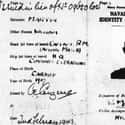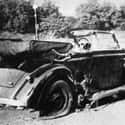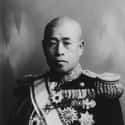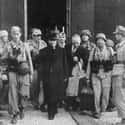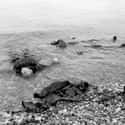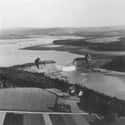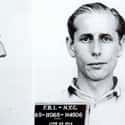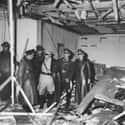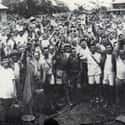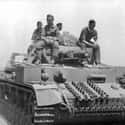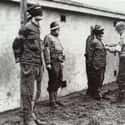-
(#1) Operation Gunnerside, The Most Crucial Mission of WWII
In February 1942, nine men parachuted into the vicinity of Vemork, Norway. They were Norwegians specially trained by British Special Operations with plans for blowing up a Nazi-controlled heavy water plant in Vemork. Heavy water was a crucial element in the production of plutonium, an ingredient for the nuclear device Hitler's scientists were feverishly attempting to build. It was the only such facility in the world.
The heavily fortified, remote plant was impervious to bombing; it could only be taken down on site, which required scaling a 500-foot-high cliff in the middle of winter and infiltrating a heavily guarded basement laboratory. The nine Norwegians, led by 23-year-old Joachim Ronneborg, did just that, successfully detonating explosives that shut down the facility. The destruction of the Vemork plan was crucial in Albert Speer's decision to halt attempts to produce a German atomic device.
-
(#2) Operation Mincemeat: The Man Who Never Was
In 1943, British intelligence was asked to help conceal Allied intentions of invading Sicily that summer. Germany and the Allies were involved in a high stakes deception/guessing game to determine just exactly where the first European attack would occur. British intelligence officers came up with the idea of Operation Mincemeat, a plan to disseminate false information by allowing the Germans to "accidentally" discover faked top secret documents.
To carry out Operation Mincemeat, the British acquired the cadaver of homeless man Glyndwr Michael, transforming him into "Major William Martin." By the time a submarine crew pushed Michael/Martin's body gently into the water off the coast of Spain, he was handcuffed to a briefcase stuffed with falsified military documents and mundane items.
Information concerning a supposed upcoming invasion of Greece was included in an official letter between two British generals. The British hoped Spanish authorities would turn this material over to German intelligence, and it would make its way up the chain of command, which is exactly what happened. Hitler had already decided Greece would be the next Allied objective. Based on info recovered from the British corpse, he diverted men and equipment to Greece. When the Allies invaded Sicily on July 10, they were met with minimal resistance.
-
(#3) Heroic Czech Resistance Executed Operation Anthropoid
In September 1941, Reinhard Heydrich, a high-ranking Nazi official and primary architect of the Holocaust, was named Reich Protector of Bohemia and Moravia (formerly Czechoslovakia). He immediately declared martial law, began executing political prisoners and intelligentsia, and deported the sizable Czech Jewish community. The Czech government, exiled in London, decided to assassinate Heydrich.
On December 28, 1941, after extensive training by British intelligence, two Czech agents, Jan Kubis and Josef Gabcik, as part of Operation Anthropoid, were successfully parachuted into Czechoslovakia. They spent several months perfecting a plan with local resistance fighters. On May 27, 1942, Kubis and Gabcik waited along Heydrich's usual morning route to the Nazi's Prague headquarters. The Reich Protector arrogantly rode in an open Mercedes convertible, thinking an attack by local citizens was inconceivable.
As Heydrich's vehicle slowed at an L-shaped curve, Gabcik pointed a machine gun at Heydrich, but it misfired. Heydrich ordered his driver to stop so he could shoot Gabcik when Kubis tossed a grenade, which detonated near the car's right fender. Both agents escaped and Heydrich, initially thinking he was uninjured, passed on June 4.
Kubis and Gabcik were betrayed by a resistance member and perished heroically, on June 18, after a gunfight with the Gestapo at a Prague church. The pair was played by Jamie Dornan and Cillian Murphy in the 2016 film Anthropoid.
-
(#4) The Nazis, The World's Oldest Profession, And Operation Kitty
Kitty Schmidt ran the most luxurious brothel in Berlin when Hitler came to power. Uncomfortable with the Nazi regime, Schmidt transported cash to British banks via Jewish refugees she helped escape Germany, with plans to leave herself. In June of 1939, she fled, but got no further than the Dutch border, where she was detained by the SD, the Nazi central security agency.
From there, Kitty was taken to Gestapo headquarters, where she was interrogated by Walter Schellenberg, chief of the SD. Schellenberg presented her with a choice: she could go to a concentration camp or keep her brothel open so the Gestapo could spy on its prestigious clientele. Kitty agreed to the latter. The brothel was quickly bugged and reopened. Nazi agents throughout Berlin sent unwitting foreign diplomats and military personnel to the salon and told them to use the code words "I come from Rothenburg."
Marks sent to Kitty by the Gestapo, identified by the above code words, were handed a book containing photos of 20 specially trained women, whose job it was to debrief the subject, in more ways than one. This scheme operated until 1943 when Allied bombings damaged the building housing the brothel beyond repair. Kitty survived WWII and lived with her secret until her passing in 1954. Schellenberg was tried as a war criminal but, because of his extensive knowledge and cooperation (and poor health), only spent two years in prison.
-
(#5) Operation Vengeance Literally Avenged Pearl Harbor
Admiral Isoroku Yamamoto, brilliant commander of the Imperial Japanese Navy, masterminded the December 7, 1941, attack on Pearl Harbor. In April 1943, Yamamoto was conducting a morale building tour of Japanese positions in the Solomon Islands when American intelligence, having broken Japanese code, figured out his itinerary. Presented with an opportunity to get the man responsible for Pearl Harbor, President Roosevelt personally ordered the subtly named Operation Vengeance.
The mission required a 1,000-mile round trip, perfect timing, and the element of surprise, all of which Americans were able to pull off. On the morning of April 18, 1943, 18 American P-38 Lightning planes were in position to intercept the Japanese admiral. Over Bougainville Island, the Americans attacked Yamamoto's bomber and fighter escort. In the ensuing dogfight, Yamamoto's plane was sent crashing into the jungle.
-
(#6) Operation Cherry Blossoms At Night And Japanese Biological Warfare
The Imperial Japanese Military routinely experimented with and utilized biological warfare during WWII. Its infamous Unit 731, commanded by Major Shiro Ishii, conducted ghastly experiments involving hypothermia, induced heart attacks, and infectious diseases on Chinese civilians and American POWs. As a result, the Japanese developed biological weapons such as bombs that could spread plague, cholera, and anthrax. These weapons were used repeatedly against Chinese cities and killed thousands of non-combatants.
Japan was hesitant to use biological weapons against the US, but as defeat loomed and the Japanese war effort became increasingly desperate, Ishii planned a massive biological attack on Southern California. Operation Cherry Blossoms at Night would direct five long distance submarines to the vicinity of San Diego. The subs would launch specially designed dive bombers carrying plague-infected fleas. The pilots of these planes would crash at the earliest opportunity, hoping to induce a plague pandemic.
Although the plan was approved in March 1945, logistics prevented it from being implemented before Japan's surrender. Ishii used his extensive knowledge of biological warfare to avoid war crimes prosecution, he passed in 1959.
-
(#7) Operation Oak, The Mission To Free Benito Mussolini
In July 1943, after the successful Allied invasion of Sicily and facing the inevitable attack on the Italian mainland, Italian government officials deposed dictator Benito Mussolini. Mussolini was arrested and transported throughout Italy, eventually ending up at the Gran Sasso, an old hotel in the rugged Apennine mountains. Hitler believed the Italians planned to surrender to, then join, the Allies, which would jeopardize Germany's southern defenses. He personally ordered Otto Skorzeny, a skilled commando and paratrooper, to locate and rescue Mussolini.
After tracking Mussolini around Italy - Italian authorities moved their prisoner regularly, to keep his location secret - Skorenzy intercepted a radio communication about Benito's movements. On September 12, 1943, Skorzeny directed German paratroopers to the mountaintop hotel where the Italian dictator was confined and captured him without firing a shot. Amid great German propaganda fanfare, Mussolini was reinstalled as the head of the Italian Social Republic, the area controlled by Germany. Skorzeny received a promotion, medals, and the acclaim that would lead Winston Churchill to dub him "the most dangerous man in Europe."
-
(#8) Operation Jubilee Was Anything But Jubilant
Almost two years before D-Day, the Allies launched an attack on the northern French coastline, at the port town of Dieppe. While this was meant as a raid and not an invasion, the mission was a disaster and an embarrassment. More than 6,000 British and Canadian soldiers attempted to seize and hold Dieppe, destroy German military positions, and practice a large scale amphibious invasion in what was known as Operation Jubilee.
Unfortunately, German troops were prepared for the assault and deployed extensive defensive positions in anticipation. None of the Allied objectives were met, and 10 hours after the initial landing, Operation Jubilee was aborted. More than 1,000 Allied troops were slain or wounded, almost 2,000 men were captured, and it wasn't until June 1944 that a similar attack was attempted. Still, many lessons learned at Dieppe were incorporated into the successful implementation of Operation Overlord, the invasion of Normandy.
-
(#9) Operation Frankton, Beyond Heroism
The French port of Bordeaux, a major shipping center, was crucial in supplying the German occupation in France. In 1942, an elite Royal Marine commando squad was ordered to penetrate the 50-mile-long Gironde River estuary, proceed to the port, and destroy as many cargo ships as possible with timed explosive devices. Because the estuary was heavily protected, the mission would have to be carried out by six canoes, with two man crews paddling all the way to Bordeaux. The mission was named Operation Frankton.
After launching from a submarine at the mouth of the estuary on the night of December 7, one canoe was damaged immediately, one capsized in five-foot swells, and two crews were captured before they made it to the port, leaving the last two canoes to carry out the mission.
Each of the surviving teams attached mines to four cargo ships then left the port. The plan called for them to destroy their canoes and attempt to reach the Spanish border. Only two of the four remaining crew members made it. Of the 10 saboteurs, two drowned, six were captured and executed under Germany's Commando Order, and two made it to Spain, from where they returned to Great Britain.
-
(#10) Operation Chastise, AKA The Dam Busters
The strategic value of Germany's Ruhr River dams was well-known to Allied intelligence. The torpedo netting and anti-aircraft defense systems at the dams made traditional bombing an unlikely and costly prospect. Under the supervision of the British Admiralty, a special drum-shaped bomb was devised. When released with a rapid backspin, the device would skip along the river surface, strike a dam, then sink. Water pressure then activated a special hydrostatic fuse to detonate it.
On May 16 and 17, 1943, 19 British Lancaster planes bombed Ruhr Valley dams in a mission known as Operation Chastise. The bombers successfully breached two dams, causing tremendous destruction. Two hydroelectric plants were disabled, about 1,300 civilians were killed, and massive flooding ensued. While the effectiveness of the operation, which had a more-than 40% British casualty rate, has been debated, the emotional impact of Operation Chastise at the time was undeniable.
-
(#11) Operation Pastorius Brought German Saboteurs To The United States
Early on the morning of June 13, 1942, young Coastguardsman John Cullen patrolled a stretch of beach near Amagansett, Long Island. Suddenly, a man came out of the fog, startling Cullen, who asked him to identify himself. The man claimed he and his group were fishermen. When the group refused Cullen's offer to come to the Coast Guard station, and after he heard one of them speaking German, Cullen was sure he was onto a plot. The leader of the group introduced himself, gave Cullen a wad of money, and warned him to forget the whole thing.
Cullen ran back to the Coast Guard station and reported the encounter. Within minutes a patrol had returned, the strangers were gone, but explosives, uniforms, and liquor were found buried on the beach. By noon, the FBI was aware of the plot and actively searching for the Germans. Two of the Germans, George Dasch and Ernst Burger, had no intention of carrying out Operation Pastorius, their mission of industrial sabotage. In New York City, Dasch attempted to turn the group in by phone, but the FBI agent who took the call thought it was a prank and hung up. Dasch then went to DC and was shuffled from FBI office to office until, in exasperation, he dumped $84,000 on a skeptical agent's desk.
The spies were quickly apprehended. J. Edgar Hoover publicly crowed about the arrests but didn't reveal the true circumstances behind the incident. President Roosevelt learned details from military tribunal transcripts. Nevertheless, he affirmed six death sentences, life for Burger, and 30 years for Dasch. Despite the fact that some of the condemned were naturalized American citizens and had committed no crimes, six saboteurs were executed. Dasch and Burger were eventually deported to Germany by Harry Truman.
-
(#12) Little Known Facts About 'Operation Valkyrie'
Most students of history have heard of Operation Valkyrie, Colonel Claus Von Stauffenberg's briefcase-bomb-attempt to blow up Adolf Hitler at his East Prussia military headquarters then seize control of Germany via military coup. Less well known is the sequence of events that allowed Hitler to escape assassination.
The location where von Stauffenberg's attempt took place was originally a subterranean concrete bunker. At the last minute, because of summer heat, the location was changed to an above ground wooden conference room. which diminished the power of the blast. Stauffenberg's wounds from fighting in North Africa left him with only one eye and one hand with three fingers. When repeated requests came from the general staff to hurry, his condition allowed him the time to prime only one of two explosive bricks.
Because of Stauffenberg's disability, an orderly offered to carry the briefcase for him and placed it inches away from Hitler. Unfortunately, after von Stauffenberg was summoned to receive a prearranged bogus phone call, Colonel Heinz Brandt moved the case behind a thick oak partition, because it was in his way. The ensuing explosion was strong enough to kill four people. Those shielded by the table leg, including Hitler, survived.
-
(#13) The Great Raid, Secret Philippine Rescue Operation
As the Japanese were driven out of the Philippines in late 1944, they began executing Allied POWs. Allied authorities feared the Japanese would kill all 513 hundred prisoners when they abandoned Cabanatuan, one of the largest prison camps in the Philippines. In January 1945, approximately 100 Army Rangers marched 30 miles behind enemy lines, linked up with Filipino guerrillas, and carefully scouted the heavily fortified compound for several days.
At sunset on January 30, 1945, the Rangers and guerillas crawled over the flat terrain surrounding the camp. The attackers quickly destroyed the Japanese guard towers and bunkers. The more than 500 prisoners made it safely back to American lines.
-
(#14) The Russian Counterattack Known As Operation Uranus
By 1942, the German offensive in the Soviet Union had stretched itself dangerously thin in its attempt to seize the oil fields of the Caucasus and capture Stalingrad. By November, the German Sixth Army occupied most of Stalingrad and seemed poised to capture it entirely. But the Soviet High command was secretly preparing a massive counterattack, Operation Uranus, which would exploit the vulnerable flanks of the Sixth Army, positions defended by relatively apathetic Italian and Romanian units.
The operation involved more than 1 million men, 1,000 tanks and aircraft, and a massive artillery barrage that began on November 19, 1942. The Romanian positions crumbled. With no German reserve units to respond, the German Sixth was trapped. Hitler's refusal to allow a strategic retreat isolated Axis troops in an encircled pocket. By the time the commander of this doomed unit, Friedrich Paulus, surrendered on February 2, 1943, less than 100,000 German troops remained. This military catastrophe was a major turning point of WWII and the beginning of the end of Nazi Germany.
-
(#15) Operation Greif Led To A Great Deal Of Grief
In December 1944, as part of the massive German counterattack that precipitated the Battle of the Bulge, a secret German Panzer brigade under the command of Otto Skorzeny prepared to spread chaos behind American lines. Operation Greif (Griffin, in German) successfully infiltrated a small number of English-speaking Germans in US uniforms behind American lines at the beginning of the offensive. These commandos switched road signs, misdirected regiments, and quickly made it back behind German lines.
Confusion took hold when four Germans were captured and one of them claimed their true mission was to make it to Paris and assassinate General Eisenhower. From that point on, American troops challenged unfamiliar soldiers with questions about baseball, state capitals, and Frank Sinatra. The military immediately placed these four, and twelve other similarly uniformed captured Germans, on trial for espionage (wearing a foreign uniform in combat was forbidden by the Geneva Convention) and executing them. Skorzeny would be acquitted after WWII.
New Random Displays Display All By Ranking
About This Tool
The espionage has never stopped, even in peaceful eras. From a spy who never appeared to a team of Nazis posing as American soldiers, many thrilling and bizarre secret operations that occurred during World War II are beyond our knowledge in history books. They were the heroes who contributed silently behind the first line of World War II, using their wisdom and courage to fight for victory.
During World War II, both the Allied Powers and the Axis Powers planned several secret operations. Many of these actions were taken risky, even unbelievable. The random tool shares the stories of 15 crazy secret WWII pperations.
Our data comes from Ranker, If you want to participate in the ranking of items displayed on this page, please click here.












